The latest report by CNNIC revealed that the size of China’s Internet users reached 989 million in 2020, with a penetration rate of 70.4%. Being part of this tremendous figure, we are educated by those digital contents flooding in from different channels, especially in the field of consumption.
Announced by the Ministry of Commerce of the PRC recently, China has been the worlds’ top online retail market for eight consecutive years. With the rapid expansion of the e-market and fierce competition inside the industry, a new challenge has emerged on how to leverage marketing power in the new era. As one of the most effective strategies to convey the brand image and engage with the targeted audience, KOL marketing is gaining more attention.
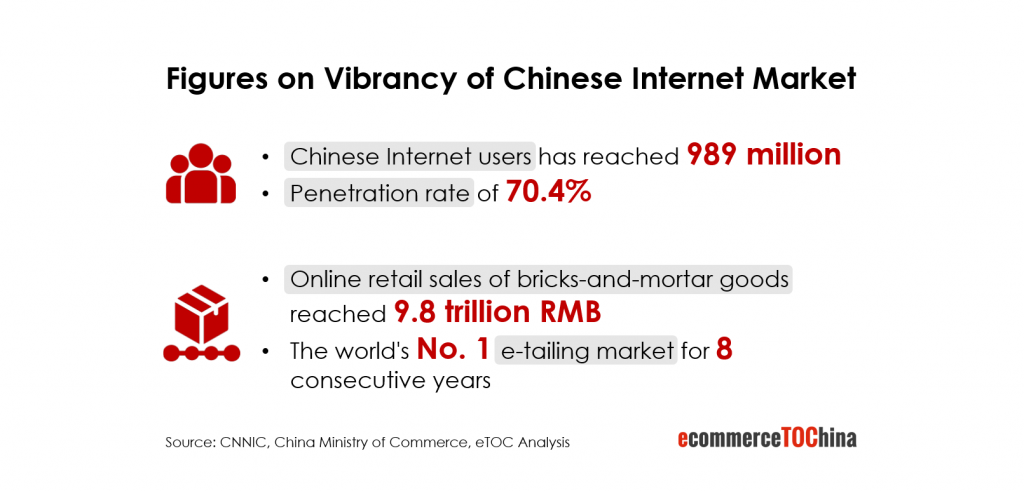
To provide a broad knowledge of KOL marketing in China, we will release blog articles from introductory to in-depth. In this article, we will focus on a brief and easy-to-follow introduction.
1. What is a Key Opinion Leader (KOL)?
1.1. Definition and example of KOL
KOL stands for Key Opinion Leader, a term initially extracted from marketing. In short, it refers to those who provide their trusted and influential opinions in a particular field. Their expertise in the specific industry or products thereby has a significant impact on the consumer behaviour of the related group.
For instance, users fond of pets tend to follow those KOLs producing quality content on pets. Over time, through interaction, follower’s interest may naturally translate into loyal trust. The bond of trust may actuate faithful fans to purchase the same pet supplies privately used or even advertised by KOLs.
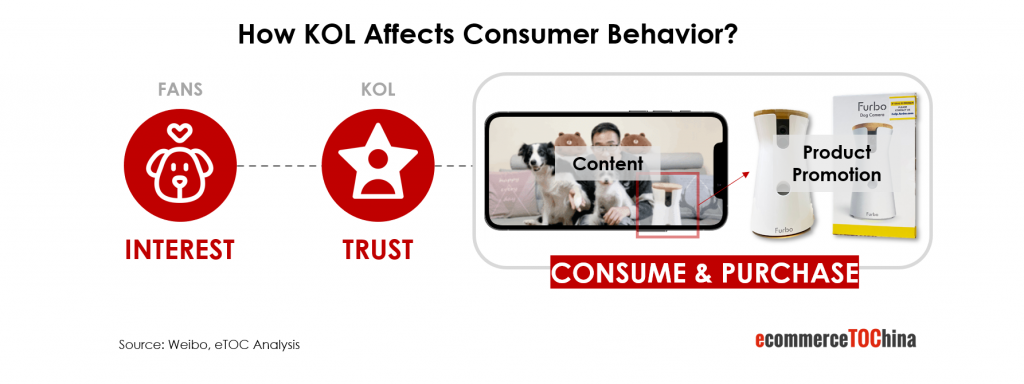
The above example thereby illustrates how KOLs cultivate and affect their fans as consumers.
1.2. Level mapping – the difference between KOL and WangHong (网红)
We are all familiar with those characters, such as milk tea girl and brother sharp, rising to fame overnight for their beauty or uniqueness. Nevertheless, one could not regard them as KOLs simply for their popularity. We may rather call them “WangHong” instead of KOL, even though the classification is getting fuzzy now.
In a strict sense, there are three types of influencers: stars and celebrities, bloggers, and WangHong (Internet celebrities).

On the one hand, stars and celebrities, and bloggers are categorized as KOLs. The former is attitude-oriented, while the latter is knowledge-oriented. For instance, Korean star G-dragon always set a powerful and valued attitude trend in his fanatical followers in China, leading these star chasers to be obsessed with his music, art, and even his home country. Bloggers such as Austin Li, well-known for his rich knowledge of cosmetics, are attracting millions of buyers to grab products in his live streaming sessions.
On the other hand, WangHong is excluded from KOL as they create a value of pan-entertainment rather than a speciality. They are often product-oriented and aim to draw buyers with their good-looking appearance. However, the boundary between KOL and WangHong is getting blurred. Some WangHongs are transforming to export their knowledge such as beauty and stabilize their fan base.
2. How does KOL marketing work?
2.1. KOL business model – from a chain to an eco-system
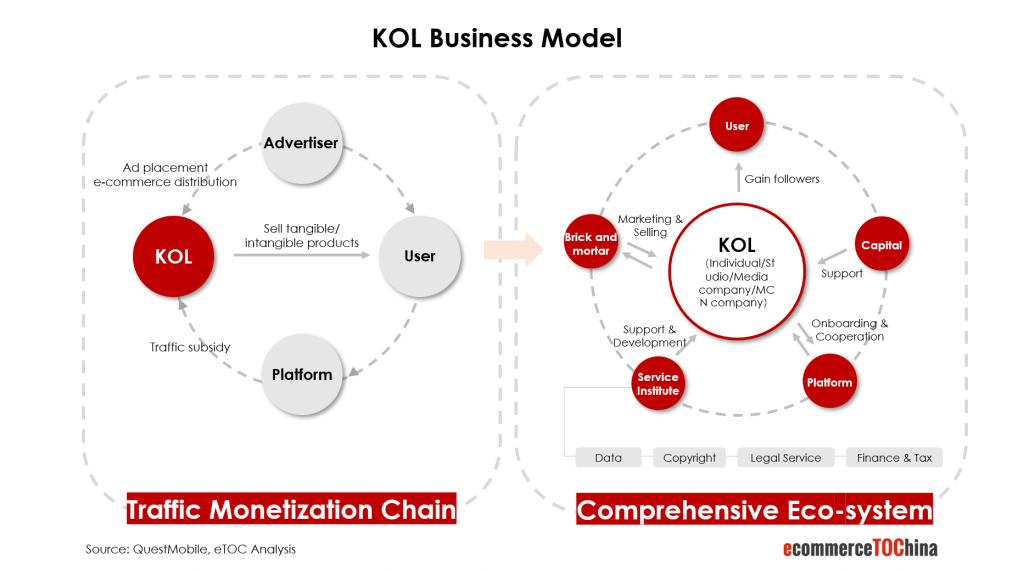
Conventionally, KOL industrial chain involves four parts: KOL, advertisers, users, and the platform. KOL, relying on the platform-subsidized traffic and own-made content, sells tangible or intangible products to users, whose revenue is also distributed with advertisers. It is a business model of traffic monetization.
Through the evolution of KOL and platform, the traditional KOL industrial chain has grown into a comprehensive eco-system. The brick-and-mortar stores have taken the place of advertisers and communicate with KOLs directly. Multi-channel network (MCN) companies, serving as KOL incubation institutions, support the KOL market with capital investment.
(MCN) companies, serving as KOL incubation institutions, support the KOL market with capital investment.
2.2 Various mechanisms – how to leverage KOL marketing
Brands are leveraging suited KOLs in different platforms. For instance, sugar-free beverages brand Genki Forest is debuting its new products on various platforms with KOLs in line with the targeted audience’s preferences and habits.
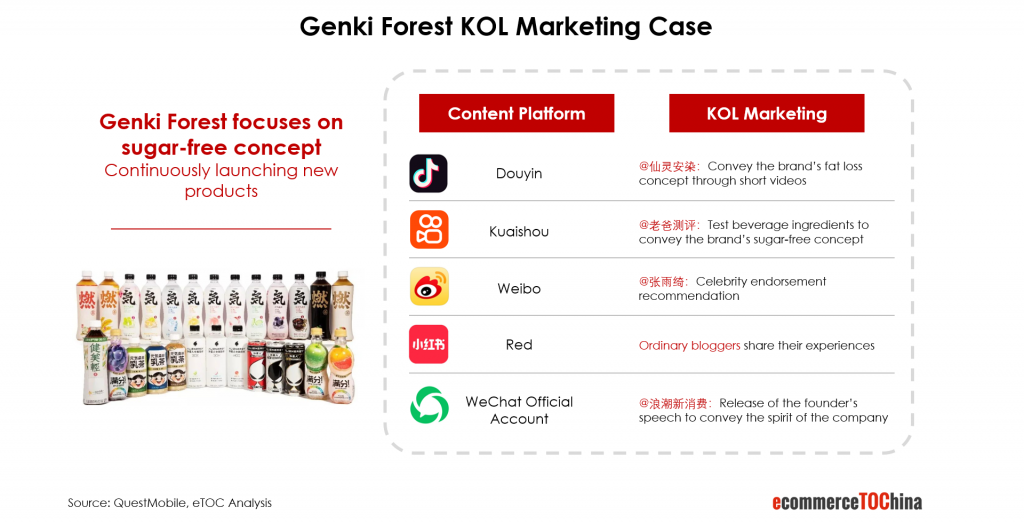
Besides, some top KOLs have licensed their images and launched IP collaboration products with other brands. For instance, popular comic IP “Wuhuang Wanshui” has collaborated with Vinda and released a set of particular tissues.
Apart from multi-channel targeting and IP collaboration, e-commerce players could develop a variety of mechanisms with KOLs.
3. KOL marketing – why is it an effective tool?
3.1. The western and Chinese customer journey comparison
With its high profitability, KOL marketing has convinced brands to spend a budget on it as a good marketing tactic. In 2018, when the influencer industry was surging from its initial stage, its market value has reached over 100 billion RMB, which is estimated by Weibo big data. The tremendous number manifests the great potential of the KOL market and the noticeable value of leveraging KOL marketing.
Its efficacy mainly lies in the seamlessness of customer journey in China. Comparing the western and Chinese customer journey, a typical Chinese consumer, once approached by KOL contents, could directly browse the product’s detail and purchase the goods through embedded links. For instance, consumers watching Austin Li’s live stream could buy the recommended products immediately in the popped-out link. To sum up, KOL content seeding and the goal of high conversion are often fulfilled at the same place.
Nevertheless, unlike the smooth customer journey in China, when certain products attract western customers appeared in social media apps (e.g., Instagram), they are often led outside the platform. For instance, when brands promote their product in collaboration with a KOL on Instagram, consumers will shift to the website and make the purchase. It is less convenient for extra efforts spending on skipping platforms, filling information, and afterward monitoring the logistics. Plus, it is less reliable since customers are already divorced from the trusted platform, and their data and rights may not be well-protected.
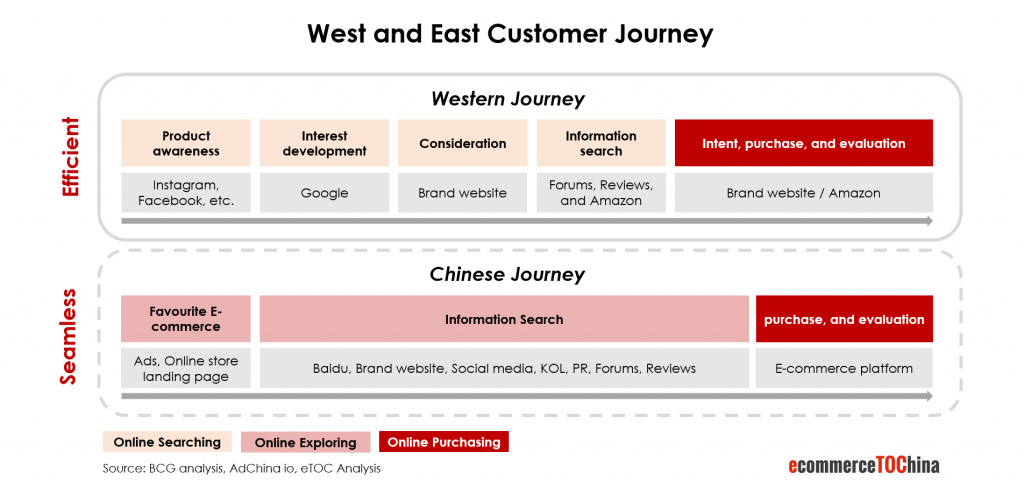
3.2. Affordability and profitability of KOL Marketing
The above comparison explains why KOL marketing is more effective in China. Besides, KOL is a marketing instrument relatively affordable and economical compared to purely celebrity endorsement. Online information revealed that fees for celebrity endorsements can mount into the tens of millions, while seeking a KOL with millions of followers for marketing usually only costs about 10,000 RMB. Moreover, influencer marketing is also profitable, backed up by Mediakix’s 2019 data, demonstrating that 89% of marketers witnessed a higher ROI yielded from influencers.
All these benefits are attracting e-commerce players to invest in KOL marketing.
4. KOL and KOL followers’ portraits
Given the data collected in 2018, most KOLs are cultivated youngsters and middle-aged people living in 1st and 2nd tier cities.

With 86% of the KOLs born between the 1980s-2000s, the middle-young crowd is the leading force of leading internet discourse. Besides, 82% of the KOLs have gained a Bachelor’s degree and above, consistent with its definition, which requires expertise in a particular field. Moreover, KOLs are almost evenly distributed in females and males. Additionally, 63% of KOL live in 1st and 2nd cities, where the economy is more developed.
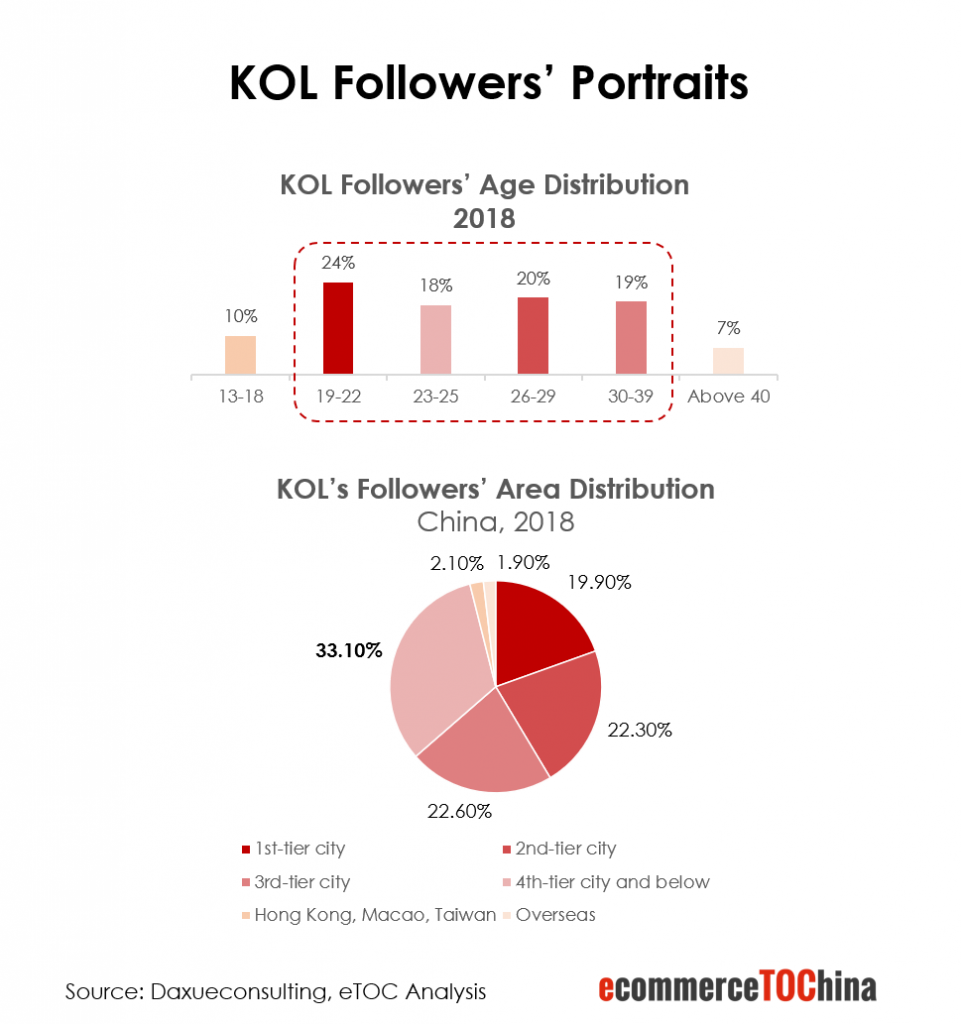
Corresponding to KOL’s portrait, KOL followers are mainly born between the 1980s-2000s, with a youngster of 19-22 accounting for 24%. Besides, KOL followers are spread over from 1st-tier city to 4th-tier city and below, with users from 4th-tier city and below taking up the most.
5. Challenges of KOL Marketing in China
Although KOL marketing is a hotspot for marketers, it is also inevitably confronted with challenges. Several reports have pointed out that youngsters are experiencing an “influencer fatigue” that consumers get annoyed with excessive KOLs’ ads.
The “influencer fatigue” is now expanding to a sentiment of distrust and disappointment. It seems that some KOLs may go too far in “marketing.” Nowadays, it becomes commonplace that the products promoted by the trusted KOL may have poor quality, withering consumers’ confidence in terms of “KOL recommendation.” Besides, as a netizen ourselves, a disappointment may also emerge when we perceive that KOL’s content is full of boring stunt for promoting goods.
Despite all these concerns, KOL marketing is still a powerful strategy in China. With numerous KOLs emerged or vanished on social media, breaking through the existed challenges requires innovative and brave initiatives, whatever from the brand-side or KOL-side, to regain customers’ favor and trust.

Discover the Future of Shopping with "Shopatainment – The Future of Shopping"
Our new book “Shopatainment – The Future of Shopping” explores how the innovative fusion of shopping and entertainment is revolutionizing the way we shop. Learn about the origins of this trend in China, the technologies and formats being used, and the opportunities and challenges it presents for the West.

Want to have a first free consultation session about how to do marketing in China? Contact us.
